

© Shipping Wonders of the World 2012-

Epics of the Submarines
Stories of men who have not only had amazing escapes from death, but who have also performed feats of unforgettable gallantry
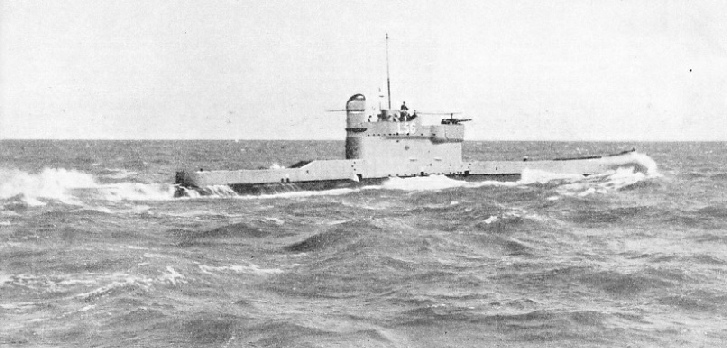
DURING the fourteen years immediately preceding the war of 1914 -
An instance is provided by the episode of H.M. Submarine A4, in October, 1905. The A class of submarine, although superior to the initial “letterless” type, displacing 180 tons, measuring 100 feet long, 11½ feet wide, drawing 11½ feet, and able to do eleven knots on the surface with the twelve-
Before this date there had been some exciting incidents, even in the calmest water. One boat, while under trial in Tilbury Dock, with the Admiralty Director of Naval Construction on board, settled herself down on the bottom so firmly that for a time her crew was gravely endangered. A second refused to answer her diving rudders and nearly drowned her crew. A third gave an obstinate display by sticking to tenacious clay. A fourth developed terrifying leaks due to pressure. In the course of some exercises, A1 was accidentally run down by a steamer and sunk.
Thus, when A4 motored out of Portsmouth Harbour towards Spithead, and had only just rounded the corner to Stokes Bay, she might or might not be courting death. No one could prophesy. She intended to make experiments relative to the transmission of sounds, and with her went H.M. Torpedo Boat No. 26. The idea was for the torpedo boat to lower a bell over the side, while A4’s hull lay just under the sea, but with a brass-
Down and down dropped the submarine, and the depth dials told the terrible truth. In those days the safety limit was 100 feet. During the war a German submarine (U 58) involuntarily submerged to 278 feet and came up. The Italian submarine Ferraris once dived to 350 feet. Thirty years ago such achievements would have been constructionally impossible. The coxswains in A4 watched the dial-
To trim for diving, a submarine first fills her ballast tanks with water by means of valves and so forfeits her buoyancy; then her propeller and hydroplanes control her in much the same manner as an airship is directed. Conversely, the submarine is lightened by the use of compressed air bottles to empty the tanks of water. When it was discovered, therefore, that gallons of seawater were pouring into A4’s inner hull from the top, it became obvious that a serious accident had happened. The available flasks of compressed air were let loose to blow out the ballast tanks.
Unfortunately the task seemed beyond human or mechanical power. Two of the tanks would not empty as fast as they should have done, and water still poured in, transforming the steel shell into a lake. Matters went from bad to worse when A4 took an ugly inclination by the bows of forty degrees. Every loose article kept washing up and down in confusion. Then all the electric lights went out.
Trapped as if at the bottom of a deep, dark well, officers and men had their own thoughts. To all of them death seemed a certainty; many of them called to mind the fate of A1; others recollected that A8 had foundered with all hands not far from Plymouth Sound, having dived unexpectedly with her conning-
But, whatever their thoughts, everybody, from the captain to the youngest seaman, was calmly performing his duty in the face of imminent death. The cause of the trouble was the open ventilator, a pipe four inches in diameter. Leading Seaman Baker, one of the hydroplane coxswains, tried to screw on the stopper and arrest the inrush; but the flood made this impossible. Then he stuffed his cap into the pipe, and also other men’s caps. When that method had little effect he pulled off his own jersey, and this had some good result.
But the situation was serious. As the loose water swished round their legs and the men slipped and slithered, they felt the hull hitting the sea-
Something happened. The hull made a movement and it developed a different trim. The boat took life again. She seemed to be lifting; the blowers were getting more powerful; the tanks were emptying. A4 was now rising as rapidly as the ballast could be ejected; yet too much optimism seemed scarcely justifiable.
Then, at the conclusion of three and a half apprehensive minutes, A4 rose once more to the surface. The conning-
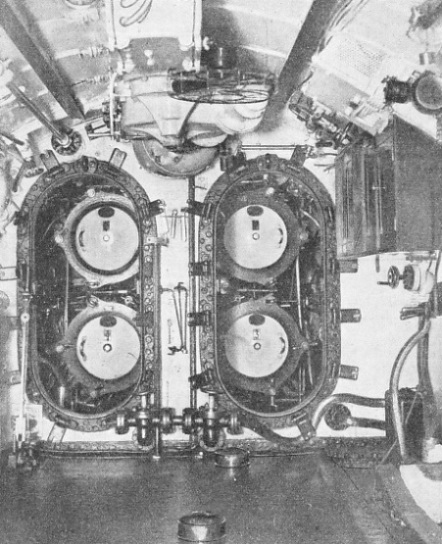 It so happened that H.M.S. Hazard came steaming along. Her captain (Commander B. W. Johnson) saw that, with A4 still down by the head and everyone on deck, something abnormal had occurred. He took the submarine in tow, and the survivors were put aboard the tender Nettle. This had been a narrow escape indeed. While A4 was being taken into harbour three internal explosions occurred, and when waiting for the dock-
It so happened that H.M.S. Hazard came steaming along. Her captain (Commander B. W. Johnson) saw that, with A4 still down by the head and everyone on deck, something abnormal had occurred. He took the submarine in tow, and the survivors were put aboard the tender Nettle. This had been a narrow escape indeed. While A4 was being taken into harbour three internal explosions occurred, and when waiting for the dock-
THE MAIN ARMAMENT of the submarine is her torpedoes. Early submarines used in the war of 1914-
The cause of the trouble was that the wash of a passing steamer had sent a deluge down the ventilator. One of the petty officers, however, testified that on an earlier occasion A4 had submerged accidentally. Luckily these sound-
It was this Lieut. Herbert who, in 1911, took the three British submarines C36, C37, and C38 on an unprecedented voyage of 10,000 miles from Portsmouth to Hong Kong. In spite of the weather, the cramped space, the lack of exercise, and the heat, the voyage was safely accomplished with little sickness. There were occasions when those aboard the escorting cruiser (who were having a fairly bad time in a gale) saw these three boats disappear under the waves as if never to return to sight.
Three years later the war of 1914-
The Rostock was a four-
out on a risky trip, would assuredly be keeping an alert look out. Moreover, she was screened by three destroyers on either bow, whose sharp stems would be deadly.
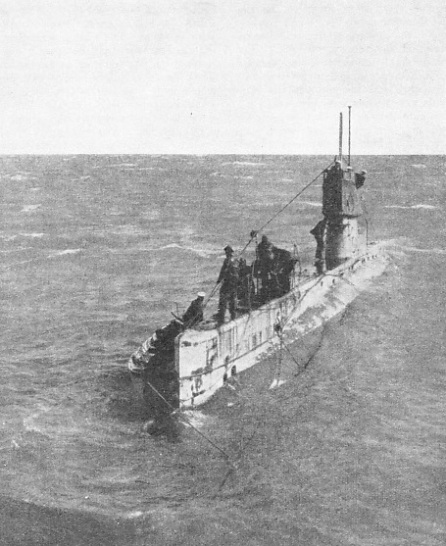
A FAMOUS SUBMARINE, C 37. This submarine with two others, C 36 and C 38, travelled in 1911 from Portsmouth to Hong Kong, a distance of 10,000 miles. The flotilla was commanded by Lieut. Herbert, and despite bad weather, cramped space, lack of exercise and the heat of these early vessels, the voyage was accomplished without a casualty. A cruiser acted as escort.
None the less, Herbert had the chance of his life -
“Why the devil didn’t you sink the cruiser?” demanded the latter.
But Herbert could not find an answer; nor was it discovered until long afterwards. The solution was simple.
When a British Naval Commission visited Germany after the war, it was learnt that the Rostock’s people had been amazed that two torpedoes should suddenly have been sighted coming from nowhere, that they had failed to hit, and that any submarine captain should have had the audacious skill to attack in such calm conditions. These torpedoes had been directed with perfect accuracy, yet they had passed below the 17 feet draught of the cruiser. This was not Herbert’s fault, but because the wartime heads of British torpedoes were 40 lb heavier than the practice-
It cannot be denied that the Germans had in their submarine service some exceedingly able and daring commanding officers, though the standard of efficiency fell off during the later stages of the war, when less experienced captains sought to achieve that which their predecessors had found difficulty in accomplishing. Few U-
On the other hand, there were some U-
left home for a North Sea cruise, and on September 2 she reached the Firth of Forth. I well remember some months later being on that station and hearing the rumour that an enemy submarine had penetrated even to the Forth Bridge. No one seemed to credit it as a fact, or to believe that a U-
A German Raider
That night the batteries did fire on what they took to be a periscope, and the Invincible sent picket-
flotilla-
Such is the fortune of war that Captain Martin-
It was Hersing, who, that same autumn, broke all records by forcing the Dover Strait and going so far west as Le Havre, where he sank shipping by the use of his gun. In the following January he created another record by penetrating right down the English Channel, and thence north into the Irish Sea. There he spread some consternation by sinking merchant steamers off the Mersey. For this he received exceptional congratulations in Germany on having accomplished a feat that had been deemed impossible. Indeed, this cruise, which so clearly demonstrated a U-
The captain of U 21 was unquestionably a brilliant submarine pioneer, a marked man who could always be relied upon to carry out the most difficult task. As such we can afford to admire him. His next adventures were more remarkable, and still more historic.
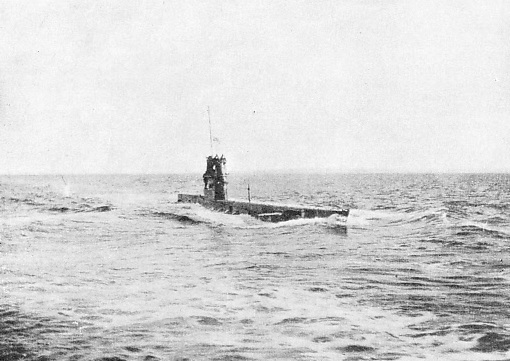
RENOWNED FOR ALL TIME. E 11 cruising along the surface. This submarine, under Commander Martin E. Nasmith twice in 1915 threaded its way through the heavily-
It will be recollected that the spring of 1915 saw the British occupied with the Dardanelles campaign, and by March both Germany and the Turks were apprehensive lest their enemies should get through the Straits to Constantinople. “If the Dardanelles fall,” wrote Grand Admiral von Tirpitz, “then the whole of the Balkans will be let loose upon us”, and “the world war has been decided against us”. The Turks asked Germany for a submarine to operate against the Anglo-
But this necessitated some hard thinking and scheming. How could a submarine go all the way from Germany to the Austrian base at Cattaro, up the Adriatic, without refuelling? It was true that five years before the Swedish submarine Hvalen, which had been built in Italy, had cruised thence across the Mediterranean, up the Atlantic, and the North Sea. But that had been in peace time, and she had called at several ports. So, also, the three British C-
Otto Hersing’s chief difficulty would never have existed in the sailing-
Hersing had used the cover of a May night and a lonely neutral bay without the Allies’ knowledge, and now, with the worst portion of his journey accomplished he was able to resume with confidence; but his troubles were not yet over.
A Perilous Dilemma
In spite of all Teutonic care, the Marsala had brought him the wrong kind of fuel oil; it had not the right specific gravity for diesels. Hersing’s mechanics tried mixing it with the original supply, but that did not prove satisfactory.
What was he to do? He had only twenty-
rough calculation indicated that he might, or more probably might not, last out until Cattaro. Being a wise and brave man, he banished all thoughts of interning U 21 in Spain, and decided to take a big risk. If he could do the journey at slow speed on the surface, and not be driven under water by Mediterranean patrols, then there was just a possibility of his winning through. So he went on.
The German submarine was sighted north of Lisbon by the S.S. Teiresias, who wondered at her nationality. Later on U 21 passed Gibraltar, but on May 6 she was chased by H.M. Torpedo Boat No. 92, and made to dive. She received some damage to her periscope, though she fired a torpedo at her pursuer. Hersing’s anxiety was increased by sighting a second torpedo boat, a steamer off Cartagena, and a French destroyer, and so he had to dive again. Finally, on May 13, he arrived at Cattaro, with scarcely half a ton of fuel left. His nineteen days’ pioneer voyage had been performed with the narrowest of margins. Thus ended the first phase of his thrilling experience.
The U 21 now had to go up to Pola for repairs, which were quickly effected. On May 20 she started off again, came up the Aegean, and reached the Dardanelles approaches. She tried to attack the Russian cruiser Askold, but failed. On May 24, at 10.30 a.m., she just missed torpedoing H.M.S. Vengeance. At 12.30 p.m. she torpedoed and sank H.M.S. Triumph, although the Triumph was lying with her anti-
The painful sensation created in Britain through Hersing’s brilliant achievement is still remembered. He sank two more ships of lesser value, but the net result of his initial venture was to place our bombarding vessels so much on the defensive that the Turks were correspondingly aided. Hersing had demonstrated the immense possibilities of one submarine working independently, and had proved the uselessness of steel nets. Thenceforth no battleship could be regarded as safe unless anchored in harbour behind boom-
In August, 1914, the British Mediterranean Fleet stationed at Malta had the three old-
Sinking a Turkish Warship
The young officers serving in these three obsolescent submarines were all keen to try and force a passage, but the problem was this. While the first part of the journey could be made on the surface, the submarine must then dive and make her progress unseen past powerful land defences. This submergence was complicated by having to meet a strong downward current (in places running at five knots), and by the known existence of mines laid athwart the route in five lines. Thus, apart from human courage, it was also a question of electricity, on which any submarine must rely for propulsion when below surface.
Now these early B-
On the other hand, she might be fortunate in making a safe passage, arrive where she hoped, raise her periscope, and find some suitable target. There might even be the Goeben lying at anchor. Who could say?
On December 13, 1914, Lieutenant Holbrook was under way on the surface, hugging the European shore of the Dardanelles, and not diving until it became necessary; for B11 would need all the electricity possible. The trip began well. Holbrook proceeded below the five explosive lines, approached near the Narrows, raised his periscope, and sighted the two-
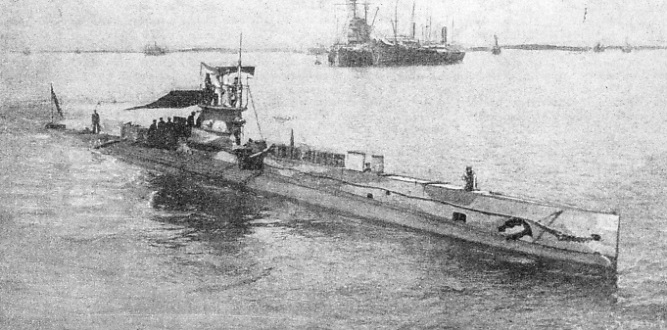
H.M. SUBMARINE E 14 at the Dardanelles. This vessel was commanded by Lieut.-
It was shortly before 10 a.m. when Holbrook got within 800 yards, steadied his submarine in the current, and fired his torpedo. He submerged more deeply, waited, heard the explosion, raised his periscope again and saw the Messudieh sinking by the stern. Within ten minutes she had disappeared; but her final effort was to send a shower of shells splashing round the periscope’s locality. Having thus made history, and achieved something that had been considered impossible, B11 turned to come home. Unfortunately, the current drove her ashore, whereupon all the Turkish land guns that could bear opened fire. Almost miraculously she bumped off, hit the bottom more than once, dodged the mines, and somehow was never hit. True, her periscope lens became fogged, and she steered “blind” for some time; but at length she saw her way clear ahead, got past all defences, and went hurrying along with the fair current.
Having performed an unprecedented feat and proved what could be done by enterprise and pluck in even a B-
We began this chapter with Lieutenant Martin E. Nasmith in the submarine A4. Ten years passed, and he was now in command of a much bigger and far more efficient submarine, E11. This quiet, cool officer brought his craft out to the Dardanelles in the spring of 1915, and by his intrepidity set a standard that it would be almost impossible to excel, though his tasks differed from the opportunities that awaited Hersing. Lieut.-
Through a Minefield
Running the gauntlet exactly describes each voyage through the Narrows, guarded not merely by underwater entanglements, but also by powerful forts on either shore. The British Army on the Gallipoli Peninsula was being hard pressed by the Turks, whose reinforcements and supplies were brought chiefly by water along the Sea of Marmara. If British submarines could reach that sea and stop this traffic, then invaluable assistance would be given to the army. So at 3 a.m. on May 19 we find E11 entering the Dardanelles Straits for another of those dangerous journeys which her “owner” had undertaken in such different regions as the Solent, the Baltic and the North Sea. Diving to 80 feet, she passed safely underneath the mines; but she was attacked in the Narrows by enemy destroyers who sighted her periscope.
Nasmith, however, reached the Sea of Marmara, and a few days later made his presence felt to some purpose. At the eastern end he torpedoed a Turkish gunboat, stopped a steamer full of Turkish troops, compelled her abandonment, and caused her to be blown up. Another steamer, also bound for the Narrows at Chanak, was so disturbed that she ran into Rodosto on the northern Marmara shore, where she lay alongside the pier. A torpedo from E11 settled her fate. Next came a paddle-
Then on his seventh day out Nasmith had the temerity to enter Constantinople at high noon, where he torpedoed a transport lying alongside the arsenal. The moral effect of such an incident within the enemy’s capital need not be stressed. Next day, near Marmara Island, E11 sighted the Turkish battleship Kheiredm Barbarossa, which had made herself troublesome by firing at long range across the peninsula at the British Fleet. This battleship had to be dealt with, and a torpedo might do it perfectly.
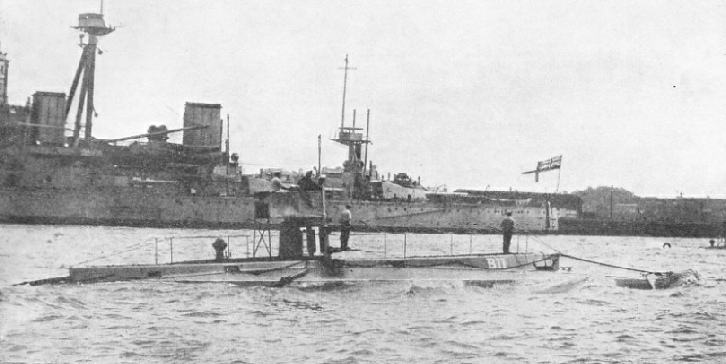
BRAVING ALMOST CERTAIN DEATH, Lieutenant Norman D. Holbrook in 1914 took the obsolescent submarine B 11 -
This was easier said than done. Nasmith tried, but could not get in his attack, and one of the escorting enemy destroyers nearly succeeded in ramming E11. Perhaps time would bring another chance? On May 26 a large cargo steamer, although escorted, was now torpedoed, and five days later in Panderma Roads, a large transport received similar treatment, though some tugs managed to tow her ashore. On June 2 some good work was done in sending an ammunition ship to the bottom. To complete this eventful voyage, Nasmith once more braved the Narrows, dodged the forts and mines, and emerged from the Dardanelles, having seriously hindered the enemy from receiving troops as well as munitions. Besides striking terror and confusion into the Turks, he had sunk one gunboat, two ammunition ships and two storeships, and had driven a transport and paddle steamer ashore.
All this may sound matter of fact, but it is necessary to imagine the discomforts on board for days and nights, the trying heat, the perpetual suspense, the continuous vigilance, the effect on nerves of the whirring of motors, and the everlasting possibility of some mechanical accident rendering the submarine a mere steel coffin. Such a disaster nearly happened; for, while on her way back below Chanak, E11 fouled a large mine. The wonder is that she was not blown to destruction; but she forged ahead towing mine, sinker and mooring-
A still more wonderful trip began in the early hours of August 5. Now fitted with a twelve-
Next day brought a fresh difficulty, for an aeroplane spotted E11 and dropped bombs, though without result. Cruising about the Sea of Marmara, this submarine met Lieut.-
After sighting Turkish troops on the march, shelling them, and torpedoing a gunboat, Nasmith once more found himself in the presence of the battleship Barbarossa. Again the battleship was being escorted by destroyers, but on this day -
Life and Death Contrast
So the days went on with variations. Once Nasmith shelled some more troops marching along the Gallipoli road; this time the enemy replied with field-
The most picturesque and exciting incident had still to follow. In the north-
Having made a raft, on which were placed a 16-
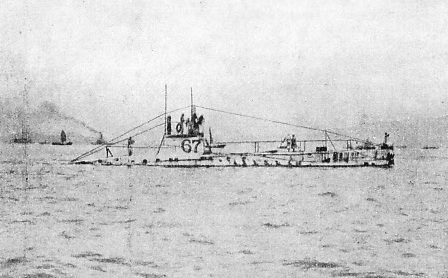
AN EARLY TYPE OF SUBMARINE. The first vessels had one propeller and little reserve of power. Every dive below the surface risked the lives of the crew. The safety limit of diving for vessels at the beginning of the war of 1914-
At a small culvert he laid his charge and fired it. He wasted no time in sprinting away down the line. Hearing the violent explosion, he knew that his mission had been fulfilled. Next came, also, the sound of Turkish pickets pursuing him. The young naval officer fired his revolver; the pickets replied with their rifles. A first-
Had she been trapped? D’Oyly-
No, this was not the first time that the upperworks of a submarine had been taken for three vague objects. It was E11 coming round a point of and. D’Oyly-
You can read more on submarines in “Beneath the Surface”, “Raising a Submarine Minelayer” and “The Unlucky K 13” on this website.